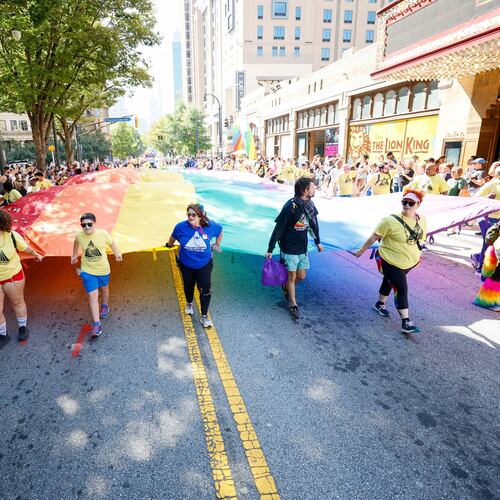An Underground Atlanta timeline:
1869: The Georgia Railroad Freight Depot built, and Alabama Street fills with traffic.
1910-1929: Concrete viaducts built over the train tracks to allow a better and safer flow of traffic, creating an underground section of the city. Many stores move to the second level, leaving the lower level for storage and the odd speakeasy.
1960s: The original first level is rediscovered and proposed as an entertainment district in the “city beneath the city.”
1969: Underground Atlanta opens, becoming an immediate hot spot for Atlanta nightlife. Popular bars include Dante’s Down the Hatch and The Blarney Stone.
1980: Underground is largely closed after years of decline and a crime wave.
1982: Mayor Andrew Young proposes to redevelop Underground.
1987: Rouse Co. begins a $142 million renovation that includes more than $80 million in city municipal bonds.
1989: Underground reopens, this time resembling a shopping mall more than an entertainment hub.
1990: Atlantans gather at Underground to celebrate the awarding of the 1996 Olympics to Atlanta, and the new World of Coca-Cola helps draw in millions of new visitors.
1992: Rioters smash windows in the wake of the Rodney King verdict, and sales plummet.
1996: Underground Festival Inc., a private entity that operates the center, loses $6.5 million despite a boost from the Olympics.
1999: Atlanta hires a team led by O’Leary Partners to manage the district.
2004: City allows bars in the complex to serve drinks until 4 a.m. in an effort to boost traffic.
2007: World of Coca-Cola moves to Centennial Olympic Park, sapping foot traffic from center.
2012: City officials step up conversations over Underground’s future, developer Dan O’Leary vows to search for “big idea” to change Underground’s dynamic.
As thousands of revelers descend on Underground Atlanta tonight to celebrate the new year, city officials are vowing a new focus in 2013 on how to make the 12-acre attraction more appealing when there’s no plummeting peach to cheer.
It’s a daunting challenge. How to invigorate Underground has long flummoxed City Hall and frustrated many who wander the site’s subterranean halls.
The annual New Year’s Eve celebration - arguably the only time when Underground lives up to its promise as a community gathering place - provides a televised showcase of the venue’s potential.
But most other days, Underground remains faint shadow of the vision for a regional entertainment mecca promised in the 1980s when millions in public funding was devoted to redeveloping the complex.
No specifics on how to move the needle have been advanced yet, but Underground’s revival is now viewed as a part of a broader effort to rejuvenate downtown, along with plans for a $1 billion Falcons stadium and a possible new transit center at the nearby Five Points MARTA station.
“When we direct tourists to Underground and Five Points, we want to make sure it represents the best of Atlanta, which it doesn’t right now,” said Duriya Farooqui, the city’s chief operating officer. “This is the right time for us to look at a solution for Underground because of the key major investments that are being planned.”
Developer Dan O’Leary, whose company has run the attraction under contract since the late 1990s, is long on dreams for Underground’s revival but, for now, short on details. He acknowledges it’s a sore spot for the city’s civic pride, though, and said his team needs time to search for a way to upend Underground.
“The best way to describe a successful Underground Atlanta, to me, is for it to be something that the majority of people would be proud of. And I know right now that they are not proud of Underground,” said O’Leary. “If it needs to be better, it needs a big idea. It’s got to be a big idea. And we know it. But big ideas take a long time to happen.”
Any transformational proposal would likely require big money, and enticing outside investors could require the renegotiation of O’Leary’s 88-year lease on the city-owned property.
The city dishes out about $8 million a year on Underground through July 2016, a payment stemming from a 1989 deal to help repay bonds that financed the construction of parking decks. The city is also on the hook for increasing annual repairs on the facility.
O’Leary’s firm pays Atlanta $100,000 per year to run the attraction, though that figure could rise if sales improve. Underground’s operators took in about $2 million in revenue in 2011, a far cry from the loftier estimates once envisioned for the complex.
The current Underground is the second major attempt at a downtown entertainment center on the site. An earlier, smaller version enjoyed a heyday during the 1970s but closed amid rising crime and falling business. Under Mayor Andrew Young, the city hired the renowned Rouse Co. to design a modern attraction that opened in 1989 with broader appeal to shoppers, diners and partiers. After an initial period of success as a regional draw, the new version drifted into decay and was only about 40 percent occupied when O’Leary arrived in 1999.
His firm tinkered with the tenant mix to make it more attractive to tourists and worked with the Atlanta Braves and MARTA to position shuttle buses on site to lure suburban traffic. It also helped convince city lawmakers to allow Underground bars to serve drinks until 4 a.m.
Underground managers estimate 6 million people a year wander through the three-tiered complex, which is nearly 80 percent occupied. But a chunk of those visitors merely use Underground to travel from one part of downtown to another, and the attraction still struggles to recover from a string of setbacks, from the recession that stung tourism to the World Of Coca-Cola Museum’s departure for the other side of downtown.
Even Invest Atlanta, the city’s economic development arm, left a building at Underground’s edge this year for fancier digs across town.
In recent years, O’Leary and others have floated a range of game-changing plans. But O’Leary’s idea for a casino went nowhere. A pitch for Georgia State University student housing flunked out. And NASCAR, offered the old Coke museum site, wound up building its museum in Charlotte.
Business leaders and local officials suggest the biggest problem facing Underground are “quality of life” concerns about the area. Translation: The panhandling, loitering and security issues at the neighboring Five Points station and along Peachtree Street.
Atlanta police statistics show 62 crimes reported at Underground this year - mostly robberies and larcenies - about the same rate as 2011. The overall crime rate in the broader downtown beat that includes Underground dropped by 15 percent, though, helped partly by the security cameras and teams of bicycle-riding cops that patrol the area.
Yet the perception of crime sticks, and high-profile shootings, such as this month’s slaying of a 24-year-old during an argument outside an Underground nightclub, don’t help.
City officials say they plan to invest in cleanliness, public safety measures and other improvements on the Peachtree Corridor in 2013, focusing on the stretch of road that runs by Underground between Five Points and the beginning of Peachtree Street.
“It’s a question of will and focus,” said Farooqui, the city’s chief operating officer. “We have made a decision that we are going to be focused and attentive to the issues that need to be solved for that corridor to be healthy for it to thrive.”
For now, some hotel concierges say they warn tourists to steer clear of Underground. A summary at the well-known TripAdvisor website calls Underground a “dimly-lit, subterranean version of a failing suburban mall, with struggling local businesses and a handful of cheaper franchises.”
Tracyjo Jorgensen, a 30-year-old from Arizona who visited Underground this month with her husband, said her friends in Powder Springs were “aghast” when she told them they went there. She couldn’t blame them for their concern when she witnessed what she believed to be a drug deal going down at Underground’s food court.
“I am not the average traveler - I seek out the unique and different in my travels - and Underground was definitely different and unique,” she said. “Just not the way it should have been.”
Another recent visitor, 23-year-old Kevin O’Brien, said he was surprised Underground didn’t better emphasize its history as the site of Atlanta’s once-bustling railroad terminus.
“The area didn’t seem all that safe and there wasn’t that much to do,” said O’Brien, who stumbled upon the area this month while visiting from Athens. “The Underground has a lot of history and if that aspect were bolstered I think it could draw tourists into the area.”
Many of the restaurants and nightclubs that initially filled Underground’s lower levels are gone. The floor level is filled with kiosks selling jewelry and sunglasses, along with stores hawking souvenirs, clothes and beauty supplies. Sara Usman, who runs an aroma shop, said her business would struggle to stay afloat if not for online sales.
“It’s very tough to get a customer,” she said.
A.J. Robinson of Central Atlanta Progress, the downtown business group, noted that Underground seems oddly isolated despite being in the middle of downtown. To the south are dark, uninviting state government buildings, and to the north is a vast tangle of rail tracks, parking lots and overpasses in the so-called “Gulch.”
He thinks that could change with plans for a new retractable-roof football stadium to replace the Georgia Dome a few blocks north, and with a possible new transit hub that could gussy up the Gulch and redo the bunker-like Five Points MARTA station.
“It all bodes well for Underground’s real estate,” said Robinson. “The location remains as good as it was when Atlanta was first conceived. It’s a good time to be thinking about the future of the whole corridor.”
O’Leary, too, remains characteristically cheerful, vowing that the next attempt to resuscitate Underground won’t involve minor tweaks but rather broad brushstrokes.
“It’s not easy but we haven’t given up,” he said. “We may be at a point where people are discouraged, but they can’t accuse us of not trying.”
About the Author
Keep Reading
The Latest
Featured



